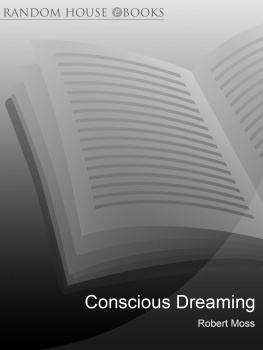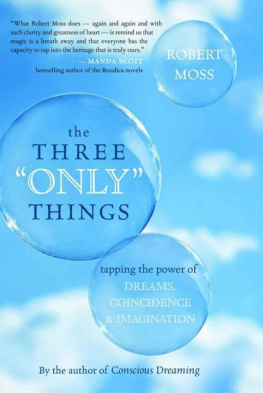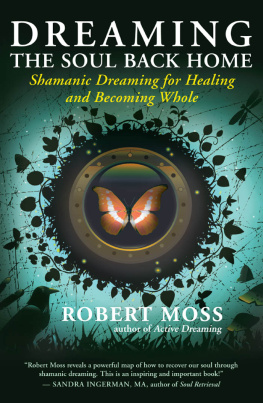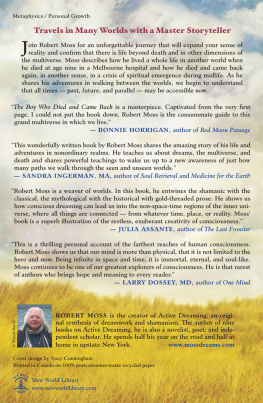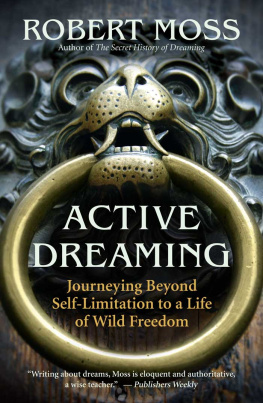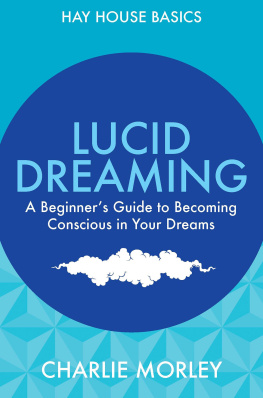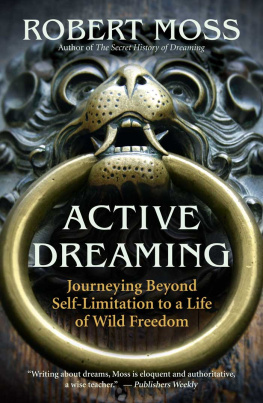ABOUT THE AUTHOR
Robert Moss is a lifelong dream explorer, shamanic teacher and a former professor of ancient history and philosophy. He has also been a journalist in London and a war correspondent in Vietnam. Born in Australia, he survived a series of near-death experiences in childhood and first encountered the ways of a dreaming people through his friendship with Aborigines. For the last 10 years he has taught and practised Active Dreaming, an approach to dreamwork that incorporates shamanic techniques. He lives in upstate New York.
Early praise for Conscious Dreaming includes:
Robert Mosss Conscious Dreaming is a triumphant contribution. With the readability of an adventure novel and the wise vision of a shaman, this book contains revelations for the advanced dreamer as well as the neophyte. Highly recommended.
Patricia Garfield, author of Creative Dreaming and
The Healing Power of Dreams
In Conscious Dreaming, Robert Moss gives us a glimpse into the reaches of consciousness and shows us what we can be. This book is highly recommended for anyone wishing to explore dreams and how they can be used constructively in the craft of life.
Larry Dossey, author of Healing Words and
Recovering the Soul
ACKNOWLEDGEMENTS
Y ou cant just sit down and write a book of this kind; you must live it. I learned in childhood that the dream world is a real worldpossibly more real than much of waking lifeand Ive been working with my personal dream journals for more than three decades. Still, it has taken me a long time to find the simplicity (and maybe the courage) to write openly about these experiences. I could not have written this book without the guidance and encouragement of many teachers and friends. Here I can honor only a few.
Among the many fellow explorers in the Association for the Study of Dreams who have fed my passion for dreamwork and my understanding of alternative approaches, I am especially grateful to Rita Dwyer, Stanley Krippner, Jeremy Taylor, Patricia Garfield and Strephon Kaplan-Williams, all generous and inspiriting teachers. Aad van Ouwerkerk helped me to realize the importance of formulating dream mottoes. The late Jessica Allena luminous beingshowed me the possibilities of dream theater. Michael Katz introduced me to techniques of Tibetan dream yoga. Joanne Rochon opened doorways into dreaming through her art and confirmed the benefits of doing dreamwork with the events of everyday life. John Hotchin lent his scientific precision to the task of logging and evaluating precognitive dreams.
In my understanding and practice of shamanic journeying techniquesand for important personal discoveriesI am greatly indebted to Michael Harner, who has led the shamanic revival in modern society, and to Sandra Ingerman, a true doctor of souls. Ginny Black Wolf, an intrepid shamanic stalker, helped me develop the methods of tracking inside the dreamscape described in this book.
I learn more about the gifts of dreaming every week from the many adventurous spirits who attend my workshops, and from members of my Active Dream circles. Wanda Burch, one of my soul sisters, has shared in many experiments over the past decade. Lonnie and Suzanne were dream allies when I most needed them.
Stuart Krichevsky has proved himself to be a dream agent, championing and shepherding this book from delivery to publication with humor, insight, and brio. Leslie Meredith and Sherri Rifikin brought me the joy of working with real editors who love their work and do it supremely well.
At my house, as in any dreaming culture, we start the day by asking, What did you dream? The best advice on handling nightmares I ever received came from my youngest daughter, when she was just four years old. My wife and daughters share in the adventure, and help me to walk the path of soul.
My deepest debt is to my teachers inside the dream world.
This is something all dreamers will understand.
REAL MEN ARE DREAMERS, TOO

I f someone tells you, I dont dream, what he or she is really telling you is, I dont remember. Sleep laboratory research has confirmed that the average person dreams for between ninety minutes and two hours every night, in no less than four to seven cycles. And these numbers only account for the dreams associated with rapid eye movement (REM), when the researchers in white coats can watch a sleepers eyeballs moving under his lids as if he were following a tennis game. Dreams and dreamlike activity are also associated with other phases of sleep. The lab research tells us little about the big dreams associated with out-of-body experiences, when the dreamer may appear to be completely inert, even comatoseor may, at the other extreme, be snoring the roof off in the style of the character Jack Nicholson plays in The Witches of Eastwick, a style that is quite unconnected with sleep apnea or other routine disorders. There are also the dreamlike experiences that come in the twilight zone between sleep and waking, which is the scene of many important visitations.
By the most conservative computation, if you add up all the time in your life you will spend dreaming, it will total at least six to seven years. Once again, the figures do not do justice to the real situation, because in dreams we are not confined to linear time: you may find that experiences that seem to occupy days, months, or even years in the dreamworld transpired in a moment of ordinary time. In the Muslim hadith there is the wonderful story of how the prophet Muhammad journeyed through all the heavens on his mystical steed, guided by Gabriel, the archangel of dreams, recorded all of the Koranand returned to find that the glass of water he had knocked over in the moment he fell into his ecstatic trance had not finished emptying.
You will dream tonight, whether or not you remember. You will have four to seven dreams (or whole series of dreams). You may also have a spontaneous out-of-body experience in the dream state. If you dream in REM sleep for markedly less than the average ninety minutes, something is interfering with you. The interference may come from drugs, including widely prescribed sedatives and sleeping pills, alcohol, caffeine, a bad conscience, serious depression, or psychic disorders for which shamans have other names. Recent scientific research indicates that people with serious depression dream considerably less than average and have very limited dream recall. Depressives often deny dreaming at all. Significantly, when a depressed patient starts dreaming more profusely (as measured from REM sleep) and reporting more dreams, this is usually a sign that he or she is out of the trough of despair and is starting to get well. This is only one of many indicators that dreaming is fundamental to our health and well-being. Serious alcoholics sometimes succeed in virtually suppressing REM-state dreams through their persistent self-abuse. The result is brain lesions and waking dementia. The dreams they have sought to drown pursue them in daylight as nightmarish hallucinations.
For the Stone Age primates from whom we are descended, sleep must have been a rather dangerous activity, with saber-toothed tigers and leathery raptors on the prowl. Dreams were the guardians of their sleep, but not in Freuds shriveled and inverted sense. Our ancestors used their dream radar to scan their external environment for dangers, while their bodies slept. I do not mean merely that through dreams they were able to process signals from the outer worldthe feral scent of a night hunter, a distant footfallwhile sleeping. Their dream radar allowed them to see and sense over great distances, farther than they could have done with their physical eyes and ears. They needed this advantage in order to compensate for their physical inferiority in relation to superbly efficient predators. Through dreams, they kept vigil. Through dreams, they were prepared for crises and challenges that lay in their future.




